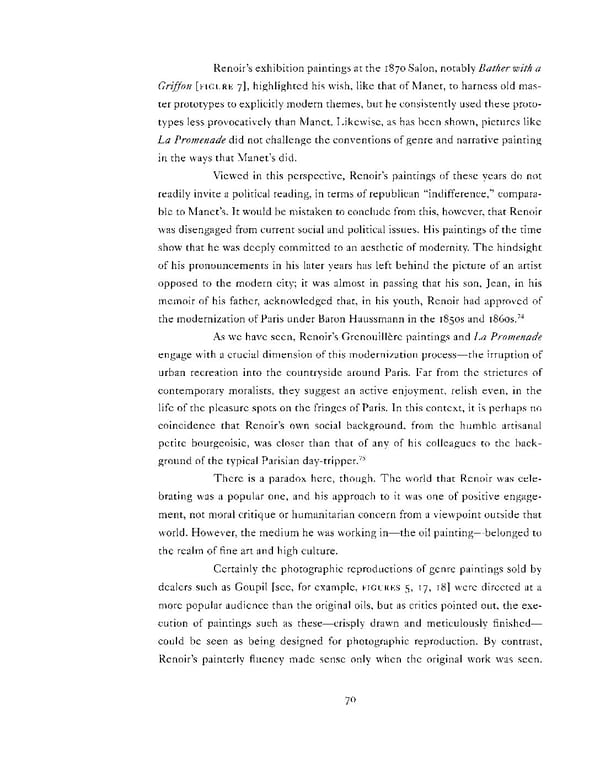Renoir's exhibition paintings at the 1870 Salon, notably Bather with a Griffon [FIGURE 7], highlighted his wish, like that of Manet, to harness old mas- ter prototypes to explicitly modern themes, but he consistently used these proto- types less provocatively than Manet. Likewise, as has been shown, pictures like La Promenade did not challenge the conventions of genre and narrative painting in the ways that Manet's did. Viewed in this perspective, Renoir's paintings of these years do not readily invite a political reading, in terms of republican "indifference," compara- ble to Manet's. It would be mistaken to conclude from this, however, that Renoir was disengaged from current social and political issues. His paintings of the time show that he was deeply committed to an aesthetic of modernity. The hindsight of his pronouncements in his later years has left behind the picture of an artist opposed to the modern city; it was almost in passing that his son, Jean, in his memoir of his father, acknowledged that, in his youth, Renoir had approved of 74 the modernization of Paris under Baron Haussmann in the 18505 and i86os. As we have seen, Renoir's Grenouillere paintings and La Promenade engage with a crucial dimension of this modernization process—the irruption of urban recreation into the countryside around Paris. Far from the strictures of contemporary moralists, they suggest an active enjoyment, relish even, in the life of the pleasure spots on the fringes of Paris. In this context, it is perhaps no coincidence that Renoir's own social background, from the humble artisanal petite bourgeoisie, was closer than that of any of his colleagues to the back- 75 ground of the typical Parisian day-tripper. There is a paradox here, though. The world that Renoir was cele- brating was a popular one, and his approach to it was one of positive engage- ment, not moral critique or humanitarian concern from a viewpoint outside that world. However, the medium he was working in—the oil painting—belonged to the realm of fine art and high culture. Certainly the photographic reproductions of genre paintings sold by dealers such as Goupil [see, for example, FIGURES 5, 17, 18] were directed at a more popular audience than the original oils, but as critics pointed out, the exe- cution of paintings such as these—crisply drawn and meticulously finished— could be seen as being designed for photographic reproduction. By contrast, Renoir's painterly fluency made sense only when the original work was seen. 70
 Pierre-Auguste Renoir: La Promenade Page 77 Page 79
Pierre-Auguste Renoir: La Promenade Page 77 Page 79